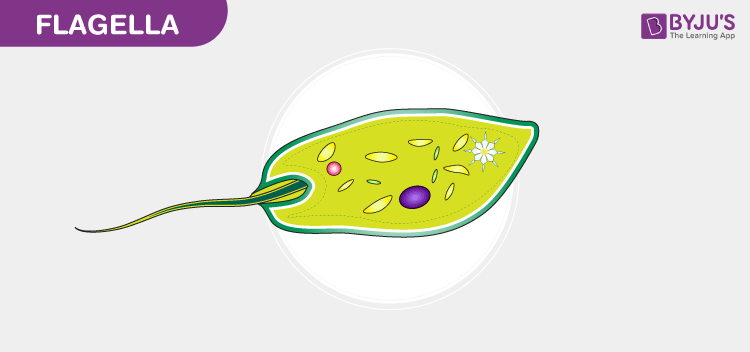Flagella are microscopic hair-like structures involved in the locomotion of a cell. The word “flagellum” means “whip”.
The flagella have a whip-like appearance that helps to propel a cell through the liquid. Some special flagella are used in few organisms as sensory organs that can sense changes in pH and temperature.
They are filamentous structures found in archaea, bacteria, and eukaryotes.
- Archaeal flagella are nonhomologous.
- Bacterial flagella are a coiled, thread-like structure, sharp bent, consisting of a rotary motor at its base and are composed of the protein flagellin. A shaft exists between a hook and a basal body passing through the protein rings in the cell membrane.
- Eukaryotic flagella are complicated cellular projections that pummel backwards and forward and are found in protist cells, gametes of plants, and animals. It is made up of a protein called tubulin.
Read on to explore flagella structure and functions in detail.

The diagram of a sperm representing Flagella Structure at the posterior end
Bacterial Flagella Structure
The flagella is a helical structure composed of flagellin protein. The flagella structure is divided into three parts:
- Basal body
- Hook
- Filament
Basal Body
It is attached to the cell membrane and cytoplasmic membrane.
It consists of rings surrounded by a pair of proteins called MotB. The rings include:
L-ring: Outer ring anchored in the lipopolysaccharide layer and found in gram +ve bacteria.
P-ring: Anchored in the peptidoglycan layer.
C-ring: Anchored in the cytoplasm
M-S ring: Anchored in the cytoplasmic membrane
Hook
It is a broader area present at the base of the filament.
Connects filament to the motor protein in the base.
The hook length is greater in gram +ve bacteria.
Filament
Thin hair-like structure arising from the hook.
Also Read: Difference between cilia and flagella
Types of Flagella
There are four different types of flagella:
Monotrichous
A single flagellum at one end or the other. These are known as polar flagellum and can rotate clockwise and anti-clockwise. The clockwise movement moves the organism forward while the anti-clockwise movement pulls it backwards.
Peritrichous
Several flagella attached all over the organism. These are not polar flagella because they are found all over the organism. These flagella rota anti-clockwise and form a bundle that moves the organism in one direction. If some of the flagella break and start rotating clockwise, the organism does not move in any direction and begins tumbling.
Lophotrichous
Several flagella at one end of the organism or the other. These are known as polar flagellum and can rotate clockwise and anti-clockwise. The clockwise movement moves the organism forward while the anti-clockwise movement pulls it backwards.
Amphitrichous
Single flagellum on both the ends of the organism. These are known as polar flagellum and can rotate clockwise and anti-clockwise. The clockwise movement moves the organism forward while the anti-clockwise movement pulls it backwards.
Flagella Function
Flagella performs the following functions:
- They help an organism in movement.
- They act as sensory organs to detect temperature and pH changes.
- Few eukaryotes use flagellum to increase reproduction rates.
- Recent researches have proved that flagella are also used as a secretory organelle. For eg., in Chlamydomonas
Cilia and Flagella
Let us have a look at the important characteristics of cilia and flagella to understand how each one is different from the other.

A comparative diagram of Cilia and Flagella
Cilia
- Grouped into the category of protozoans, class Ciliata, in the Ciliated epithelium of the Metazoa and other classes.
- It is usually present on the outer body surface such as larva of certain Mollusca, Annelida, and Nemertines, thus helping in locomotion.
- It has similar structures and function as that of flagella, but cilium is shorter and movement is quite different.
- They are present in large numbers.
- Cilia exhibit beating motion.
- Cilia often cover the entire cell.
- They fuse into some protozoans to form cirri.
Flagella
- These are present in protozoans, choanocyte cells of Metazoa and in other classes- in plants, in gamete cells, and in algae.
- They are fairly long.
- They are fewer in number.
- It exhibits a coiled motion.
- They are usually found at one end of the cell.
- Flagella usually do not fuse.
Also Read: Cilia
For more information on Flagella and other related topics such as flagella structure, types of flagella, flagella function, and cilia and flagella, keep visiting BYJU’S website or download BYJU’S app for further reference.
Frequently Asked Questions on Flagella
- The flagella arises from?
A flagellum is a hairlike appendage protruding from a range of microbes referred to as flagellates. Flagellum is mainly involved in motility. The flagellum in some bacteria can also function as a sensory organelle. These organelles are defined by function rather than structure. The flagella arises from the basal body.

Comments